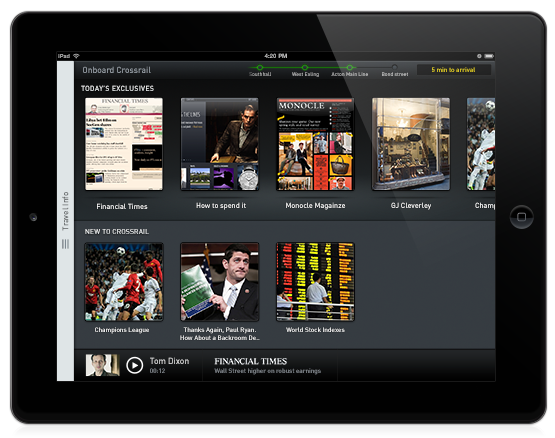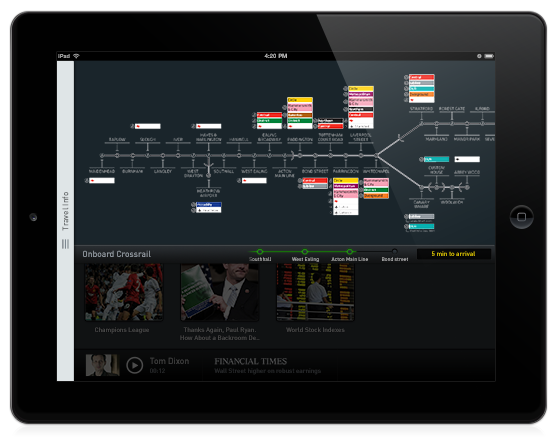Everyday of the week I travel on the Southeastern rail network, taking the high-speed service to and from Kent and London St Pancras. The service is great with comfortable seats and a respectable amount of legroom.
Like the majority of other commuters I spend most of my travelling time focusing on either something paper based (a newspaper or printed out documents) or on a screen (mobile, tablet or computer).
A quick look at my fellow commuters one evening I could see that those using their digital devices were either watching a film or TV show, reading an e-book, playing games, working and/ or accessing social media networking sites. It’s clear that screen interaction is a compelling activity for many commuters.

Crossrail 2015 Looking forwards—the commuters using the Crossrail service in 2015, will no doubt be showing similar behaviour.
Crossrail will carry around 200 million commuters each year in to Central London and is one of the largest engineering projects undertaken in the UK. There will be up to 24 trains an hour at peak times running between Paddington and Whitechapel. Such immediate access into and across central London will appeal to a great deal of premium customers, enticing them out of their cars and on to this new and fast rail network.
The combination of affluent customers, high spec infrastructure and the enormous projected passenger numbers provides a massive opportunity to create a world leading and revolutionary rail customer experience and service.

Crossrail app concept
A large part of the Crossrail journey will be deep underground, and when it isn't, the landscape changes so much with big buildings and bridges that a stable mobile internet connection is impossible. Therefore free WiFi should be considered a minimum standard in 2015. When National Express introduced free WiFi to their services, they witnessed a threefold increase in passengers, so the benefits of offering free basic internet access are not only clear from a business perspective but a necessity for customers in this day and age.
Given the mix of premium customers and their needs along with the mode of transport, there’s no reason why an in-flight type experience would not work well in this context. However, unlike an in-flight system, the on-board experience does not have to be tethered to the back of the seat in front of a commuter. The creation of an app accessible via a multitude of customer owned digital devices would be a far more appropriate and cost effective solution. An app would not only provide the Crossrail network with a powerful and easy to maintain customer solution, but offer customers a much more personalised and contextual experience overall.
For example, the app could be the customers’ portal into a Crossrail branded world of both free and premium content including recent film releases, financial news, TV series, sports events, music and games. Any on board announcement could be broadcast through the app via the customer’s headset with a subtle and visual countdown keeping them informed of the progress of their specific journey.
All content and media could be hosted on the train and streamed to the customer through WiFi to retain the highest speed possible. Content could be updated as frequently as required by Crossrail with the branding, monetisation and user experience opportunities being huge.
Building on this, a feature designed using on board security cameras to instruct customers were available seats are, would be a welcome treat for many seasoned commuters. It would also help with service load and distribute passengers evenly throughout the train.
Outside of the carriage, the Crossrail app could support the commuters’ daily grind to work by offering timely travel updates, tickets renewal reminders, schedules and last train home alerts for example. These are all standard features included within many popular travel apps but Crossrail has the opportunity to create a seamless and all encompassing premium experience for its customers. Ultimately you could imagine a future passenger on Crossrail purchasing a season ticket with the app included in the same bundle.

Conclusion
Such awe-inspiring transport projects like this deserve the very best in every single aspect of delivery from engineering, to architecture and even all the way through to customer service initiatives.
By offering an on-board customer orientated experience through an app, Crossrail could enhance its positioning and public perception, helping consolidate its cutting edge profile. Besides offering additional revenue opportunities and a platform for direct customer communication, the marketing opportunities surrounding this type of unique customer experience would also help grow Crossrail’s brand and garner interest on a global level.